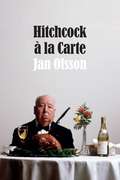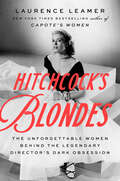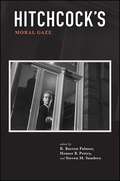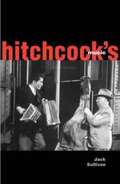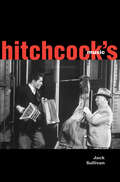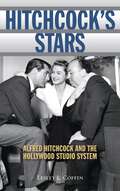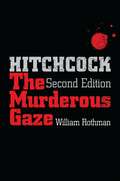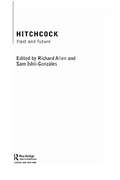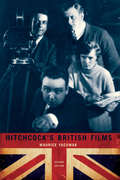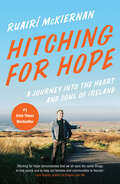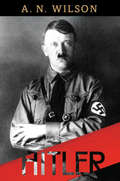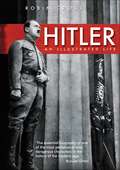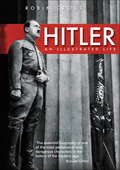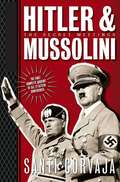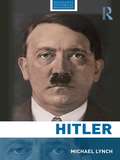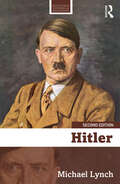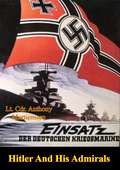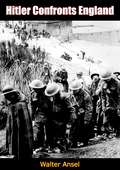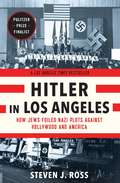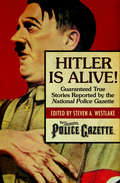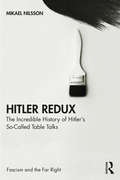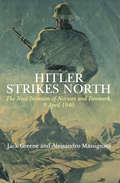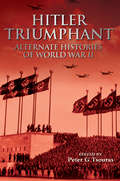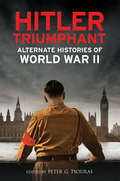- Table View
- List View
Hitchcock à la Carte
by Jan OlssonAlfred Hitchcock: cultural icon, master film director, storyteller, television host, foodie. And as Jan Olsson argues in Hitchcock à la Carte, he was also an expert marketer who built his personal brand around his rotund figure and well-documented table indulgencies. Focusing on Hitchcock's television series Alfred Hitchcock Presents (1955-1962) and the The Alfred Hitchcock Hour (1962-1965), Olsson asserts that the success of Hitchcock's media empire depended on his deft manipulation of bodies and the food that sustained them. Hitchcock's strategies included frequently playing up his own girth, hiring body doubles, making numerous cameos, and using food--such as a frozen leg of lamb--to deliver scores of characters to their deaths. Constructing his brand enabled Hitchcock to maintain creative control, blend himself with his genre, and make himself the multi-million-dollar franchise's principal star. Olsson shows how Hitchcock's media brand management was a unique performance model that he used to mark his creative oeuvre as strictly his own.
Hitchcock's Blondes: The Unforgettable Women Behind the Legendary Director's Dark Obsession
by Laurence LeamerBestselling author of Capote&’s Women Laurence Leamer shares an engrossing account of the enigmatic director Alfred Hitchcock that finally puts the dazzling actresses he cast in his legendary movies at the center of the story.Alfred Hitchcock was fixated—not just on the dark, twisty stories that became his hallmark, but also by the blond actresses who starred in many of his iconic movies. The director of North by Northwest, Rear Window, and other classic films didn&’t much care if they wore wigs, got their hair coloring out of a bottle, or were the rarest human specimen—a natural blonde—as long as they shone with a golden veneer on camera. The lengths he went to in order to showcase (and often manipulate) these women would become the stuff of movie legend. But the women themselves have rarely been at the center of the story, until now.In Hitchcock&’s Blondes, bestselling biographer Laurence Leamer offers an intimate journey into the lives of eight legendary actresses whose stories helped chart the course of the troubled, talented director&’s career—from his early days in the British film industry, to his triumphant American debut, to his Hollywood heyday and beyond. Through the stories of June Howard-Tripp, Madeleine Carroll, Ingrid Bergman, Grace Kelly, Janet Leigh, Kim Novak, Eva Marie Saint, and Tippi Hedren—who starred in fourteen of Hitchcock&’s most notable films and who bore the brunt of his fondness and sometimes fixation—we can finally start to see the enigmatic man himself. After all, &“his&” blondes (as he thought of them) knew the truths of his art, his obsessions and desires, as well as anyone.From the acclaimed author of Capote&’s Women comes an intimate, revealing, and thoroughly modern look at both the enduring art created by a man obsessed…and the private toll that fixation took on the women in his orbit.
Hitchcock's Moral Gaze: Hitchcock's Moral Gaze P (SUNY series, Horizons of Cinema)
by R. Barton Palmer; Homer B. Pettey; Steven M. SandersIn his essays and interviews, Alfred Hitchcock was guarded about substantive matters of morality, preferring instead to focus on discussions of technique. That has not, however, discouraged scholars and critics from trying to work out what his films imply about such moral matters as honesty, fidelity, jealousy, courage, love, and loyalty. Through discussions and analyses of such films as Strangers on a Train, Rear Window, Vertigo, North by Northwest, and Frenzy, the contributors to this book strive to throw light on the way Hitchcock depicts a moral—if not amoral or immoral—world. Drawing on perspectives from film studies, philosophy, literature, and other disciplines, they offer new and compelling interpretations of the filmmaker's moral gaze and the inflection point it provides for modern cinema.
Hitchcock's Music
by Jack SullivanFor half a century Alfred Hitchcock created films full of gripping and memorable music. Over his long career he presided over more musical styles than any director in history and ultimately changed how we think about film music. This book is the first to fully explore the essential role music played in the movies of Alfred Hitchcock. Based on extensive interviews with composers, writers, and actors, and research in rare archives, Jack Sullivan discusses how Hitchcock used music to influence the atmosphere, characterization, and even storylines of his films. Sullivan examines the director's important relationships with various composers, especially Bernard Herrmann, and tells the stories behind the musical decisions. Covering the whole of the director's career, from the early British works up to Family Plot, this engaging look at the work of Alfred Hitchcock offers new insight into his achievement and genius and changes the way we watch-and listen-to his movies.
Hitchcock's Music
by Jack Sullivan"A wonderfully coherent, comprehensive, groundbreaking, and thoroughly engaging study&” of how the director of Psycho and The Birds used music in his films (Sidney Gottlieb, editor of Hitchcock on Hitchcock). Alfred Hitchcock employed more musical styles and techniques than any film director in history, from Marlene Dietrich singing Cole Porter in Stage Fright to the revolutionary electronic soundtrack of The Birds. Many of his films—including Notorious, Rear Window, Vertigo, North by Northwest, and Psycho—are landmarks in the history of film music. Now author and musicologist Jack Sullivan presents the first in-depth study of the role music plays in Hitchcock&’s films. Based on extensive interviews with composers, writers, and actors, as well as archival research, Sullivan discusses how Hitchcock used music to influence his cinematic atmospheres, characterizations, and even storylines. Sullivan examines the director&’s relationships with various composers, especially Bernard Herrmann, and tells the stories behind some of their now-iconic musical choices. Covering the entire director&’s career, from the early British works up to Family Plot, this engaging work will change the way we watch—and listen—to Hitchcock&’s movies.
Hitchcock's Stars: Alfred Hitchcock and the Hollywood Studio System
by Lesley L CoffinAlthough he was a visual stylist who once referred to actors as cattle, Alfred Hitchcock also had a remarkable talent for innovative and creative casting choices. The director launched the careers of several actors and completely changed the trajectory of others, many of whom created some of the most iconic screen performances in history. However, Hitchcock’s ability to fit his leading men and women into just the right parts has been a largely overlooked aspect of his filmmaking skills. In Hitchcock’s Stars: Alfred Hitchcock and the Hollywood Studio System, Lesley L. Coffin looks at how the director made the most of the actors who were at his disposal for several decades. From his first American production in 1940 to his final feature in 1976, Hitchcock’s films were examples of creative casting that strayed far from the norm during the structured Hollywood star system. Rather than examining the cinematic aspects of his work, this book explores the collaboration the director engaged in with some of the most
Hitchcock, Second Edition: The Murderous Gaze (SUNY series, Horizons of Cinema)
by William RothmanFirst published in 1982, William Rothman's Hitchcock is a classic work of film criticism. Written in an engaging style that is philosophically sophisticated yet free of jargon, and using over nine hundred images from the films to illustrate and back up its critical claims, the book follows six different Hitchcock films as they unfold, moment by moment, from first shot to last.In addition to a thoughtful new preface and the original readings of The Lodger (1927), Murder! (1930), The 39 Steps (1935), Shadow of a Doubt (1943), and Psycho (1960), this expanded edition includes a groundbreaking new chapter—now the book's longest—on Marnie (1964), Hitchcock's most heartfelt yet most controversial film. Hitchcock never tired of quoting Oscar Wilde's line, "And all men kill the thing they love." Dark moods therefore prevail in the five original chapters, culminating in the reading of Psycho, but in demonstrating how Marnie overcomes, or transcends, the murderous aspect of Hitchcock's art, this new chapter balances the scales and gives an important new dimension to the book.With exemplary precision, Hitchcock, Second Edition shows how Hitchcock films express, cinematically, serious thoughts about such matters as the nature and relationships of love, murder, sexuality, marriage, and theater—and about their own medium. In so doing, it keeps faith with the idea that Hitchcock was a master, perhaps the master, of what he called the "art of pure cinema." However, insofar as it investigates philosophically the conditions of authorship in the medium of film, it is an auteurist study unlike any other. By attending to the films themselves and to the ways we experience them, rather than allowing some theory to dictate what to say about them, the book proves the fruitfulness of an approach that is open and responsive to the ways serious films are capable of teaching us how to think seriously about them.
Hitchcock: Past and Future
by Richard Allen Sam Ishii-GonzálesThis new collection of writings on Alfred Hitchcock considers Hitchcock both in his time and as a continuing influence on filmmakers, films and film theory. The contributions, who include leading scholars such as Slavoj Zizek, Laura Mulvey, Peter Wollen, and James Naremore, discuss canonical films such as Notorious and The Birds alongside lesser-known works including Juno and the Paycock and Frenzy. Articles are grouped into four thematic sections: 'Authorship and Aesthetics' examines Hitchcock as auteur and investigates central topics in Hitchcockian aesthetics. 'French Hitchcock' looks at Hitchcock's influence on filmmakers such as Chabrol, Truffaut and Rohmer, and how film critics such as Bazin and Deleuze have engaged with Hitchcock's work. 'Poetics and Politics of Identity' explores the representation of personal and political in Hitchcock's work. The final section, 'Death and Transfiguration' addresses the manner in which the spectacle and figuration of death haunts the narrative universe of Hitchcock's films, in particular his subversive masterpiece Psycho.
Hitchcock’s British Films: Second Edition (Contemporary Approaches To Film And Media Ser.)
by Maurice YacowarA reissued classic that examines the structure and themes of each of Hitchcock's British feature films.
Hitching for Hope: A Journey into the Heart and Soul of Ireland
by Ruairí McKiernanA modern travel tale—part personal pilgrimage, part political quest—that captures the power of human resilience <P><P> "McKiernan sticks his thumb out, and somehow a healthy dose of humanity manages to roll up alongside him. . . . This book is a paean to nuance, decency and possibility."—Colum McCann, National Book Award winner and New York Times bestselling author of Let the Great World Spin and Apeirogon. <P><P> Following the collapse of Ireland’s Celtic Tiger economy, social activist Ruairí McKiernan questions whether he should join the mounting number of emigrants searching for greater opportunity elsewhere. McKiernan embarks on a hitchhiking odyssey with no money, no itinerary and no idea where he might end up each night. His mission: to give voice to those emerging from one of the most painful periods of economic and social turmoil in Ireland’s history. Engaging, provocative and sincere, Hitching for Hope is a testimony to the spirit of Ireland. It is an inspirational manifesto for hope and healing in troubled times.
Hitler
by A. N. WilsonA ruthless dictator who saved his country from economic ruin only to nearly destroy it#151;and an entire people#151;in his quest for world domination, Adolf Hitler forever changed the course of history. In this masterful account of Hitler’s life, biographer A. N. Wilson pulls back the curtain to reveal the man behind the mythic figure, shedding new light on Hitler’s personality, his desires, and his complex relationship with the German people. While Hitler maintained that his life had been characterized by #147;struggle” from its very beginnings, Wilson shows that the reality could not have been more different. Hitler grew up in middle-class comfort and, as a young man, lacked ambitions of any sort besides a vaguely bohemian desire to become an artist. And while the Hitlerian mythos holds that he forged his skills as a leader during the First World War, Wilson explains the truth: Hitler spent most of the war as an office boy miles from the front lines, and only received his cherished Iron Cross because of his slavishness to the officers he served. The army gave him a sense of purpose and brotherhood, however, which continued to inspire Hitler once the war ended. Hitler left the army with no skills, contacts, or money#151;and yet, within fourteen years, he would become chancellor of the German nation. Wilson describes the story of Hitler’s ascent as one of both opportunism and sheer political shrewdness. He possessed no real understanding of the workings of government but had a prodigious knack for public speaking, and found that a large number of Germans, despairing at their country’s recent defeat and terrified by the specter of international communism, were willing to listen to the right-wing fantasies that had taken root inside his head. Allying himself with the extremist German Workers’ Party (soon renamed the National Socialist Party), Hitler offered many Germans a seductive vision of how the country might raise itself back up and reclaim its rightful place at the center of world politics. Wilson shows that, although Hitler’s bid for power stalled at first, he soon gained traction with a German public starved for hope. Using his skills as a manipulator, Hitler found himself first at the head of the Nazi Party, then at the helm of the German nation. Wilson explores the forces that allowed Hitler to become Chancellor of Germany, and later to march Germany into total war. He examines Hitler’s increasingly virulent anti-Semitism and his decision to implement the Final Solution to exterminate European Jews, and he considers Hitler’s tactical successes#151;and failures#151;in World War II. Wilson also reveals a great deal about how Hitler’s personal life affected his time as Germany’s leader, from the lasting pain caused by the death of his mother and the suicide of his young niece to his poor health and addiction to the drugs prescribed by his doctor. As Wilson demonstrates, Hitler the Führer was not so different from Hitler the bohemian: lazy, moody, and hypersensitive, he ruled more through intimidation and the mystifying force of his personality than through any managerial skill or informed decision-making. His story#151;and that of Germany#151;is ultimately a cautionary tale. In a modern era enamored with progress, rationality, and modernity, it is often the darkest and most chaotic elements of society that prove the most seductive. Hitler’s unlikely rise to power and his uncanny ability to manipulate his fellow man resulted in the deaths of millions of Europeans and a horrific world war, yet despite his colossal role in world history, he remains mythologized and, as a result, misunderstood. In Hitler, A. N. Wilson limns this mysterious figure with great verve and acuity, showing that it was Hitler’s frightening normalcy#151;not some otherworldly evilness#151;that makes him so truly terrifying.
Hitler
by Robin CrossAs Chancellor of Germany between 1933 and 1945, Adolf Hitler exercised unrestricted power over his country's social, political, and economic life. From Hitler's belligerent re-armament programme to his imposition of anti-Semitic legislation and territorially aggressive policies, respected historian Robin Cross maps out the life of one of the most evil men ever to have lived. This succinct and powerful account, illustrated with rare and chillingly evocative photographs, is the essential companion for anyone with a fascination for the twentieth century, the Second World War or the age of dictators.
Hitler
by Robin CrossAs Chancellor of Germany between 1933 and 1945, Adolf Hitler exercised unrestricted power over his country's social, political and economic life. Hitler's belligerent re-armament programme, his imposition of anti-Semitic legislation and his territorially aggressive policies led to genocide and worldwide conflict on an unprecedented scale. Although the subject of numerous biographies and fictional portrayals, there have hitherto been few succinct, factual narratives of Hitler's life. Hitler is a short chronicle of the Fuhrer's career, amplified with numerous rare photographs and artefacts from the period. Second World War expert Robin Cross offers a clear outline of Hitler's progress: from his unhappy childhood as the son of a minor Austrian official in Braunau, to his inglorious early occupation as a jobbing Viennese artist; from his formative experiences as a corporal in the First World War, to his emergence as leader of the National Socialist Workers' Party in the 1920s; from his extraordinary rise to supreme power in 1933, to his suicide amidst the ruins of Berlin in 1945. Commanding, informative and stylish, and written by a scholar who is steeped in knowledge of the period, Hitler is an essential companion for anyone with a fascination for the twentieth century, the Second World War or the age of dictators.
Hitler
by Robin CrossAs Chancellor of Germany between 1933 and 1945, Adolf Hitler exercised unrestricted power over his country's social, political and economic life. Hitler's belligerent re-armament programme, his imposition of anti-Semitic legislation and his territorially aggressive policies led to genocide and worldwide conflict on an unprecedented scale. Although the subject of numerous biographies and fictional portrayals, there have hitherto been few succinct, factual narratives of Hitler's life. Hitler is a short chronicle of the Fuhrer's career, amplified with numerous rare photographs and artefacts from the period. Second World War expert Robin Cross offers a clear outline of Hitler's progress: from his unhappy childhood as the son of a minor Austrian official in Braunau, to his inglorious early occupation as a jobbing Viennese artist; from his formative experiences as a corporal in the First World War, to his emergence as leader of the National Socialist Workers' Party in the 1920s; from his extraordinary rise to supreme power in 1933, to his suicide amidst the ruins of Berlin in 1945. Commanding, informative and stylish, and written by a scholar who is steeped in knowledge of the period, Hitler is an essential companion for anyone with a fascination for the twentieth century, the Second World War or the age of dictators.
Hitler & Mussolini
by Santi Corvaja Robert MillerFew political associations have had as disastrous an outcome as the one forged between Adolf Hitler and Benito Mussolini. The Axis alliance in defeat ultimately destroyed its two founders and their regimes, as well as the lives of millions of people in Europe, Africa, and Asia in the process. Yet the deeper motivations that were the root cause of the alliance between Germany and Italy, with the added ingredient of Imperial Japan and the political and personal relationship between Hitler and Mussolini, are explained while many aspects remain strangely mysterious even to this day. This book offers a complete chronicle of the Axis alliance.
Hitler (Routledge Historical Biographies)
by Michael LynchAdolf Hitler is the most notorious political figure of the twentieth century. The story of his life, how he became a dictator, and how he managed to convince so many to follow his cause is a subject of perennial fascination. Balancing narrative and analysis, this biography employs a chronological approach to describe the main features of Hitler’s career. Set against the background of developments in Germany and Europe during his lifetime, the text tells the extraordinary story of how an Austrian layabout rose to become Führer of the Third Reich. The chapters incorporate into their narrative the major debates surrounding Hitler’s ideas, behaviour and historical significance. Particular attention is paid to his experience as a soldier in 1914 -18 and to the reasons why his original left-wing sympathies transmuted into Nazism. Arguments over the real character of Hitler’s dictatorship are analysed and a measured assessment is offered on the disputed issues of how far Hitler initiated the Third Reich’s domestic and foreign policies himself and to what extent he was controlled by events. His destructive leadership of wartime Germany is now a subject of close scrutiny among historians and the book’s final chapters deal with this theme and offer a set of reflections on Hitler’s relationship with the German people and his legacy to the German nation. Michael Lynch provides a balanced guide to this most difficult of figures that will be enlightening for students and general readers alike
Hitler (Routledge Historical Biographies)
by Michael LynchAdolf Hitler is the most notorious political figure of the twentieth century. The story of his life, how he became a dictator, and how he managed to convince so many to follow his cause is a subject of perennial fascination. Balancing narrative and analysis, this biography employs a chronological approach to describe the main features of Hitler’s career. Set against the background of developments in Germany and Europe during his lifetime, the text tells the extraordinary story of how an Austrian layabout rose to become Führer of the Third Reich.This second edition has been fully updated to incorporate the research and literature from the last ten years, including several major studies by British and German scholars that have added to our understanding of Hitler and the Third Reich. New light has been shed on the character of National Socialism and on Hitler as a person and a political figure. Fresh insights have been made into the Hitler cult and into the charismatic nature of Hitler’s rule over Germany. Modern historians continue to wrestle with questions that still demand an answer – why did the nation that had made a unique contribution to European culture willingly follow Hitler on his nihilistic path? Using an essentially narrative approach to the Hitler story, the new edition incorporates the key findings of current research into the political, socio-economic and military features of the Third Reich that Hitler sought to create before his irrationalities destroyed it. Referencing the major historiographical disputes and drawing on the new perspectives that modern research provides, this second edition addresses the issues that historians regard as central to the study of Hitler’s Germany.Michael Lynch provides a balanced guide to this most difficult of figures that will be enlightening for students and general readers alike.
Hitler And His Admirals
by Lt. Cdr. Anthony MartienssenA fascinating and penetrating portrait of the Kriegsmarine and their relationship with Nazi Germany and Hitler."In this present book I have combined the evidence given at Nuremberg with the material contained in the Führer Conferences on Naval Affairs. It is impossible to cover every aspect of the war in one volume, and I have confined myself to the history, naval and political, which is, I think, a most revealing side of Nazi Germany."I must warn the reader that, as this history deals mainly with strategy and diplomacy, there are only a few examples of individual Nazi crimes. It should be borne in mind that the Nazis imprisoned, murdered and tortured--at a conservative estimate--twelve million people."It is also inevitable that Hitler should emerge from these pages as a talented and very able man. He was the sole ruler of a powerful, modern nation for twelve years, and obviously he could not have been a fool; but lest there are some who think that cleverness is the sole criterion of greatness, I should like to quote from Hitler's sixteenth-century tutor, Nicolo Machiavelli: "Yet it cannot be called talent to slay fellow-citizens, to deceive friends, to be without faith, without mercy, without religion....His barbarous cruelty and inhumanity with infinite wickednesses do not permit him to be celebrated among the most excellent men. What he achieved cannot be attributed either to fortune or to genius.""
Hitler Confronts England
by Walter AnselIn the fateful summer of 1940 Germany stood astride a prostrate Europe while the world held its breath and wondered, “Where next?” Hitler’s war machine had smashed Poland the previous fall, and the dull months of “Sitzkrieg” which followed had gradually lulled the Allies into anticipation of settlement. Then, in the spring, the German legions had suddenly burst into Denmark and Norway and through the Low Countries and France to the Channel coast. What could stop them?The German leader, Adolf Hitler, had rolled up an immense strategic initiative. It seemed plain that England came next. He mounted a powerful invasion force at the Channel. The troops trained and drilled, the ships formed and reformed. Yet the operation never sailed on its mission. “Why Not?” has been a tantalizing question ever since. The full answer may never be given. In it may lurk the first signs of Germany’s eventual defeat.Other studies have presented the problem through the events and their documentation. This book treats it along two distinct but related lines: along the line of a running evaluation of the German leadership and the command relationships that that leadership imposed, and along the line of an examination of the German invasion capability as judged by a naval officer long experienced in amphibious warfare.As a Forrestal Fellow of the U. S. Naval Academy during 1952 and 1953, Admiral Ansel consulted high and low participants of the invasion planning, ordering mounting, and drilling. He found little doubt about the seriousness of the German effort. He was able to discuss with the men involved the import of, and interpretation placed on, the orders and plans issued. From these factors he was enabled to bring his own professional judgment to bear on the operation’s prospects.
Hitler In Los Angeles: How Jews Foiled Nazi Plots Against Hollywood And America
by Steven J. Ross<P>No American city was more important to the Nazis than Los Angeles, home to Hollywood, the greatest propaganda machine in the world.<P> The Nazis plotted to kill the city’s Jews and to sabotage the nation’s military installations: plans existed for hanging twenty prominent Hollywood figures such as Al Jolson, Charlie Chaplin, and Samuel Goldwyn; for driving through Boyle Heights and machine-gunning as many Jews as possible; and for blowing up defense installations and seizing munitions from National Guard armories along the Pacific Coast.<P> U.S. law enforcement agencies were not paying close attention--preferring to monitor Reds rather than Nazis--and only Leon Lewis and his daring ring of spies stood in the way.<P> From 1933 until the end of World War II, attorney Leon Lewis, the man Nazis would come to call "the most dangerous Jew in Los Angeles," ran a spy operation comprised of military veterans and their wives who infiltrated every Nazi and fascist group in Los Angeles. <P>Often rising to leadership positions, this daring ring of spies uncovered and foiled the Nazi’s disturbing plans for death and destruction. Featuring a large cast of Nazis, undercover agents, and colorful supporting players, Hitler in Los Angeles, by acclaimed historian Steven J. Ross, tells the story of Lewis’s daring spy network in a time when hate groups had moved from the margins to the mainstream.
Hitler Is Alive!: Guaranteed True Stories Reported by the National Police Gazette (Police Gazette #1)
by Steven A. WestlakeActual articles from the notorious sensationalist journal that was a forerunner to the scandal sheets and tabloids of today: &“Ridiculous alt-history fun&” (Booklist). As the Allied armies closed in on Berlin, the Nazi high command scrambled to escape their shattered city. On May 1, 1945, reports went out that Adolf Hitler and his mistress, Eva Braun, committed suicide in an underground bunker—but their bodies were never found. In this landmark exposé by the legendary National Police Gazette, the truth is finally told. As peace fell across Europe, two U-Boats made mad dashes for Argentina, remaining underwater for weeks at a time to evade detection. In their incredible journeys lies the shocking secret of how the greatest mass murderer in history escaped punishment for his crimes. In the aftermath of World War II, the Police Gazette ruthlessly investigated any rumor of Hitler&’s survival in South America. Hitler Is Alive! is a true epic of twentieth-century sensationalism.
Hitler Redux: The Incredible History of Hitler’s So-Called Table Talks (Routledge Studies in Fascism and the Far Right)
by Mikael NilssonAfter Hitler's death, several posthumous books were published which purported to be the verbatim words of the Nazi leader – two of the most important of these documents were Hitler's Table Talk and The Testament of Adolf Hitler. This ground-breaking book provides the first in-depth analysis and critical study of Hitler’s so-called table talks and their history, provenance, translation, reception, and usage. Based on research in public and private archives in four countries, the book shows when, why, where, how, by and for whom the table talks were written, how reliable the texts are, and how historians should approach and use them. It reveals the crucial role of the mysterious Swiss Nazi Francois Genoud, as well as some very poor judgement from several famous historians in giving these dubious sources more credibility than they deserved. The book sets the record straight regarding the nature of these volumes as historical sources – proving inter alia The Testament to be a clever forgery – and aims to establish a new consensus on their meaning and impact on historical research into Hitler and the Third Reich. This path-breaking historical investigation will be of considerable interest to all researchers and historians of the Nazi era.
Hitler Strikes North: The Nazi Invasion of Norway and Denmark, 9 April 1940
by Jack Greene Alessandro MassignaniA detailed account of Germany&’s groundbreaking Operation Weserübung, the first three dimensional—land, sea, air—strategic invasion in history. The German invasion of Denmark and Norway in April 1940 brought a sudden and shocking end to the &“Phoney War&” in the West. In a single day, multiple seaborne and airborne landings established German forces ashore in Norway, overwhelming the unprepared Norwegian forces and catching the Allied Powers completely by surprise. Their belated response was ill-thought-out and badly organized, and by June 9 all resistance had formally ended. The strategic importance of Scandinavian iron ore, shipped through the port of Narvik to Germany, was the main cause of the campaign. The authors show how Allied attempts to interdict these supplies provoked German plans to secure them, and also how political developments in the inter-war years resulted in both Denmark and Norway being unable to deter threats to their neutrality despite having done so successfully in the First World War. The German attack was their first &“joint&” air, sea, and land operation, making large-scale use of air-landing and parachute forces, and the Luftwaffe&’s control of the air throughout the campaign would prove decisive. Although costly, particularly for the Kriegsmarine, it was a triumph of good planning, improvisation and aggressive, determined action by the troops on the ground. Making full use of Norwegian, Danish, and German sources, this book is a full and fascinating account of this highly significant campaign and its aftermath both for the course of the Second World War and the post-war history of the two countries conquered with such unprecedented speed.
Hitler Triumphant: Alternate Decisions of World War II
by Peter G. TsourasEdited by the author of Disaster at D-Day, a collection of alternative histories that force readers to consider what could happen if the Nazis won World War II. Based on a series of fascinating &“what ifs&” posed by leading military historians, this compelling new alternate history reconstructs the moments during the Second World War that could conceivably have altered the entire course of the war and led to a German victory. Based on real battles, actions, and characters, each scenario has been carefully constructed to reveal how at points of decision a different choice or minor incident could have set in motion an entirely new train of events altering history forever. Scenarios in this volume include the fall of Malta in 1942 and the likely consequences and the possibility of Halifax making peace with Hitler. Contributors include John Prados, editor of The White House Tapes: Eavesdropping on the President; David Isby, editor of Fighting the Invasion and The Luftwaffe Fighter Force; and Nigel Jones, author of The War Walk and Rupert Brooke: Life, Death and Myth.Praise for Hitler Triumphant&“An entertaining work of counter-factual history, with some thought-provoking material on the overall course of the war.&” —History of War&“The analysis of battle strategy and military might makes for a top pick for military readers seeking more than fantasy speculation.&” —Midwest Book Review
Hitler Triumphant: Alternate Histories of World War II
by Peter G. TsourasEdited by the author of Disaster at D-Day, a collection of alternative histories that force readers to consider what could happen if the Nazis won World War II.What if Winston Churchill's plane had been shot down and Halifax had become Prime Minister? Or what if Goering had taken power after a successful assassination of Hitler? Or what if Italy had not joined the Third Reich and the Axis?Inspired by a series of hypothetical questions posed by leading military historians, this compelling collection of alternate histories rewrites moments in World War II that could conceivably have altered the entire course of the war and led to a German victory.Based on real battles, actions, and characters, each scenario has been carefully constructed to reveal how different decisions or minor incidents could have set in motion an entirely new chain of events, altering history forever. Other scenarios in this volume include the fall of Malta in 1942, a successful Stalingrad breakout, and a disastrous attempt to open a second front on the Cherbourg peninsula in 1943.Contributors include John Prados, editor of The White House Tapes: Eavesdropping on the President; David Isby, editor of Fighting the Invasion and The Luftwaffe Fighter Force; and Nigel Jones, author of The War Walk and Rupert Brooke, Life, Death and Myth.Praise for Hitler Triumphant“An entertaining work of counter-factual history, with some thought-provoking material on the overall course of the war.” —History of War“The analysis of battle strategy and military might makes for a top pick for military readers seeking more than fantasy speculation.” —Midwest Book Review
